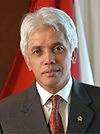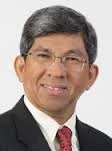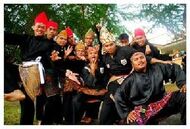
| |||||||||||||||||||||
| Total population | |||||||||||||||||||||
|---|---|---|---|---|---|---|---|---|---|---|---|---|---|---|---|---|---|---|---|---|---|
| approx. 27.8 million | |||||||||||||||||||||
| Regions with significant populations | |||||||||||||||||||||
| |||||||||||||||||||||
| Languages | |||||||||||||||||||||
|
Standard Malay, various Malay dialects, Indonesian, Thai, Yawi, English, Arabic | |||||||||||||||||||||
| Religion | |||||||||||||||||||||
| Related ethnic groups | |||||||||||||||||||||
|
Javanese people, Minangkabau people, Tausūgs, Filipinos, other Austronesian people |
The Malays (Malay: Melayu, Jawi: ملايو), or more-specifically "Ethnic Malays" (in order to avoid confusions with Malay Race) are an Austronesian ethnic (ethno-religious according to some sources) group that is indigenous to the Malaccan region of Southeast Asia. This would include the Malay Peninsula (shared between West Malaysia and southern Thailand), Singapore and the eastern parts of Sumatra. They are also native to the coastal regions of the island of Borneo. The ethnic Malays are part of the bigger Malay Race which encompasses all of the Austronesian groups in Southeast Asia and Oceania.
The ethnic Malays are descended from the many Malayic-speaking civilizations that thrived in eastern Sumatra, Peninsular Malaysia and southern Thailand. This region is traditionally known as the Alam Melayu, or the Malay realm. The modern-day Malay identity (speaking Malay and being Muslim) evolved from influence of the Malacca Sultanate, which created a nationalism of Malay culture that largely influenced the other Austronesian-speaking civilizations through the migration of voyages of Malays outside their traditional realm, especially those in the rest of the Indonesian Archipelago as far as Thailand and the Philippines.
Etymology
The possible etymologies of Malay are from ancient Chinese and Indian contexts, people from these two groups
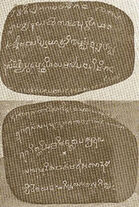
The Kedukah Bukit Inscription
had a high desire to travel to the Malay Archipelago.
- Indian mythology mentions a place far east of the Indian Subcontinent named Malayadvipa which translates into "mountainous" in Old Sanskrit. Some historians argue that this was referring to Sumatra in Indonesia, where the Malay language originated.
- I-Tsing (Chinese: 義淨 Yi Jing or I-Ching), a Chinese monk from the Tang Dynasty; visited maritime Southeast Asia and stumbled across the Malayu Kingdom (Chinese: 末羅瑜國 Ma La Yu) which also hints a possible origin for the term. Its speakers were also that of an early Malay dialect.[6]
I-Tsing is also credited with having translated Buddhist scripts from Sanskrit/Pali to Chinese. Malay was already spoken as the lingua franca and eventually the native language of these kingdoms. The earliest document written in the Malay language is a small metal plate inscription in the Indonesian island of Sumatra, known as the Kedukan Bukit Inscription.[7] Modern-day definitions and concepts of a Malay also differ. In Malaysia, the qualifications of being Malay originate from nationalist sentiments. Known as "Malayness" or Kemelayuan, these include speaking Malay, professing Islam and keeping royal tradition. This can apply to some Austronesian non-Malay groups living in Malaysia, such as the Buginese and Javanese both of which are native to Indonesia. In Indonesia, the usage of the "Malay" or Melayu only refers to the native Malay-speakers in the country since Malay is regarded as a separate indigenous language from Indonesian, the national language. In the Philippines, no distinctions are made between Malays as in ethnicity or ethnic family. The Muslims of the southern Philippines have a misconception of being called Malay, and despite following a Malay-influenced culture, are not considered ethnic Malays since they do not speak the language natively.
History
Early History & Ancestry
The ethnic Malay people have several various ancestral origins themselves, containing a hodgepodge of Austro-Asiatic,
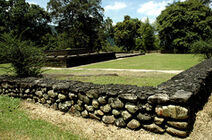
Ruins of an ancient kingdom in Malaysia's Bujang Valley in Kedah
Austronesian, Indian and Chinese origin. Malays are descended from two prehistoric migrations, a maritime migration of Austronesian people from Taiwan, China and Philippines; and a land migration from China to the Malay Peninsula, into Thailand, Singapore and Peninsular Malaysia and into Sumatra of Austro-Asiatic tribes. Indian traders introduced the Indo-Aryan languages, such as Sanskrit and Pali. They brought over the religions of Hinduism, Buddhism and later, Islam, to the Malay Archipelago. Due to the arrival of Islam, Malaysia and Brunei are home to many prominent Malay families that contain Arab ancestry such as those in Putrajaya which is Malaysia's religious capital. As with other Southeast Asian civilizations, the early Malay kingdoms were discovered by Chinese travellers to the region.
Melayu Kingdom 688-695 B.C.
The existance of the classical kingdom known as Malayu (Chinese: 末羅瑜國 Mòluóyú Guó) is rooted
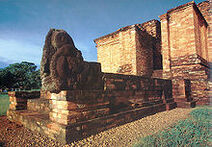
Candi Gumpung, a Buddhist temple at Muaro Jambi of Malayu Kingdom, later integrated as one of Srivijaya's important urban center.
from I-Tsing's accounts on his voyages to Southeast Asia. This kingdom had very close ties with Srivijaya, it is noted that it could have been a vessel kingdom to Srivijaya, or any nature that involved Srivijayan control.
This extract from I-Tsing accounts gives a brief description of his travel route between Bogha (Srivijaya) and the civilization known as the Malayu.
"Wu Hing came to Bogha after a month's sail. The king received him very favourably and respected him as a guest from the land of the son of heaven of the Great Tang. He went on board the king's ship to the country of Malayu and arrived there after fifteen days sail. Thence he went to Ka Cha, again after fifteen days. At the end of winter he changed ship and sailed to the west."
I-Tsing describes its location in this next excerpt,
"In the country of Sribogha, we see the shadow of the dial-plate become neither long nor short (i.e "remain unchanged" or "no shadow") in the middle of the eighth month (Autumnal equinox), and at midday no shadow falls from a man who is standing on that day, so it is in the middle of spring (Vernal equinox)."
The descriptions of the geographical instruments lead many historians to pin-point a kingdom spanning the earth's equator. The kingdom could have spanned northeastern Sumatra, Malacca and Pelambang. Buddhism was the predominant religion in this particular state, the Hinayana section. [8]
Srivijaya Kingdom 600-1200
According to the Kedukan Bukit Inscription, in 682 A.D., a military leader by the name of Dapunta Hyang Sri Jayanasa came to Palembang from Tamwan and Jambi with 20,000 soldiers. In Pelambang, Sri Jayanasa
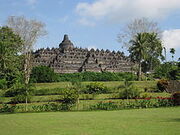
The Ancient Srivijayan Hindu temple in Borobudur, Indonesia
established a central capital that became the Srivijaya Empire (c. 600-1200 A.D.), which became one of the main region of power in the Malay Peninsula and Southeast Asia. I-Tsing arrived in Srivijaya in 688 A.D. and stayed there for seven years. He referred to the Srivijayan kingdom as Bogha which was a trader partner of China. The Arabs and Persians therefore also became aware of Srivijaya, and led to the latter Islamization of the Malay Archipelago. Armies from the nearby island of Java threatened the Malay communities in Sumatra. In 990, a Javanese kingdom known from central Java known as the Mataram
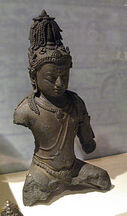
A 9th century statue of Maitreya from Sumatra in Indonesia
invaded Srivijaya but failed to conquer it which led to the establishment of a military protectorate with China at Chulamanivarmadeva's (ruler of Srivijaya) request. In 1006 A.D., the Srivijayans conquered Mataram. The Indians had not forgotten about the Malay Archipelago, prompting an invasion led by Rajendra Chola from the Coromandel Peninsula in India. Chola also failed to conquer Srivijaya. In 1025 however, he led a re-strengthened invasion that gave him new territory in Sumatra and the Malay Peninsula. All that remained was Palembang in Indonesia, with Javanese naval forces would siege. Palembang's kings turned to China again for military aid, but it was too late, the conquest of Palembang was complete and the Chinese officials that were sent there were killed by the new Javanese rulers.[9] Srivijayan politics reflected Indian influence. Rajahs and datus were Austronesian governers of lower-ranking nobility. They ruled states known as rajahnates smaller principalities known as barangays. Sri was also a title of supreme royalty, also of Indian influence. After Melayu and Srivijaya's defeat against Javanese armies, Malays came under Javanese rule in the Majapahit Empire until Islam's arrival which would form the backbone of the enmity between these two groups that perrsisted over the centuries.[10][11] The Srivijaya Empire's power and monopoly was vanquished, at the hands of Indian invaders led by Rajendra Chola.
Indian Invasion and Rule
In 1025 A.D., Rajendra Chola, who ruled from a South Indian dynasty based in Tamil Nadu, led many maritime invasions and raids in Sumatra and Kedah (then the polity of Kadaram). This event is rather paradoxical, due to the millenia-long friendly and peaceful relations between the civilizations of modern-day India and Indonesia. The Srivijayans were unprepared for the invasion, therefore Chola's invasion was swift, taking direct routes from the Bay of Bengal to western Sumatra. After capturing and imprisoning Srivijaya's kings, Chola's invasion took a trickle-down effect on the Malay realm, continuing to conquer the other Malay kingdoms and polities, including Kadaram in modern-day Kedah, as well as Palembang, capturing and imprisoning their rulers as well as hoarding their treasures and wealth. Cities were also sacked and plundered.
The monsoons of Southeast Asia seemed to be a recipe for Chola's swift naval and military successes against the Malay civilizations in Sumatra and the Malay Peninsula. This allowed for Chola's forces to move swiftly from port to port - leaving Srivijaya's defenses unable to provide any sort of reliable response to the invasion.[12][12][13] The war ended with a victory for the Cholas and major losses for the Srivijaya Empire ending the Srivijaya maritime monopoly in the region.[14][15][16][17]
Soon afterwords, Rajendra Chola married a local Malay princess.[18] Despite the devastation and chaos left by the invasion, the Malays were not under direct rule or administration, as the goal of the invasion was clearly to plunder rather than occupy Sumatra. Rather, it divided the Malays into separate small polities. The Malays also rather absorbed Tamil influence, and accepted Tamil rulers into the royalty.
Rajahnate of Cebu 1200-1565
Much of the information regarding the Rajahnate of Cebu, is found from Visayan and Philippine folklore, as well as the Italian historian Antonio Pigafetta who documented the ancient Philippine civilizations during the Spanish expedition to the archipelago. This kingdom was known to have started around 1200 A.D. According to Visayan folklore, the Chola dynasty in Sumatra, sent a minor prince, by the name of Rajamuda Lumaya known more commonly by Sri Lumay, to the central Philippine island of Cebu to establish a vassal state and a base. Sri Lumay, of Malay and Tamil descent, and settled with several sons and his family.[19] One of his sons, was Sri Alho who ruled southern Cebu. Sri Lumay's descendants would play a major role, in the Spanish conquest of the Philippine islands.
Instead of continuing his mission for the Chola Dynasty, Sri Lumay rebelled and found his own kingdom, what historians commonly refer to as the Rajahnate of Cebu (Malay: Kerajaan Sugbu). This particular kingdom is evidence of strong Indian and Malay influence in ancient Philippines.
Upon the Islamization of the Malay Archipelago, Sri Lumay battled the Muslim invaders from the southern neighboring island of Mindanao. They were referred to a Magalos, meaning "destroyers of peace". Sri Lumay was well-known for his use of scorched-earth policy for the Muslim invaders, leaving nothing for them to loot or plunder. It is for this reason where the name "Cebu" originates, from the Malay word sugbu as well as its Cebuano cognate sugbo, which means "scorched-earth".
Its capital was known as Singhapala, which today is modern-day Cebu City, and was known by the Malay phrase Kota Raya Kita, meaning "Our Great Fortress".
Islamization & Golden Age of Sultanates
Circa 674 A.D., Arab traders introduced Islam in Sumatra in Indonesia but in 1100 A.D., Indian Muslim converts arrived in Kedah and converted its population to Islam. Malay rulers who converted to Islam became sultans.
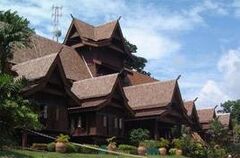
Replica of a Sultan's Palace in Malacca
Phra Ong Mahawangsa, the Hindu king of Kedah, converted to Islam and changed his name to Muzaffar Shah, and became the first recorded sultan and convert in Malaysian history. The Kedah Sultanate therefore became Malaysia's first recorded-sultanate.[20] In 1405, Zheng He (1371-1433), a Chinese Muslim eunuch from the Ming Dynasty arrived in Java in Indonesia and Malacca on the way through his voyages in Southeast Asia. There, he became a main driving force in the mass conversion of the Southeast Asian natives to Islam.[21] He made more voyages in 1413, 1416 and 1433 and went back to Java and Malacca, converting more people to Islam.[22] During the 1416 and 1433 voyages, he reached Palembang in Malaysia and strengthened Islam in the region, characterizing and re-shaping the Malay culture of Malaysia. Many of the royal figures in the Malay regions adopted Islam and adhered to its traditions. The traditional rajahs or datus retained their ruling positions many converted to Islam and either became missionaries or subjects to sultans.
Sultanate of Malacca 1402-1511
In 1402, Parameswara, a Hindu prince from Singapore, converted to Islam and turned the ancient Srivijaya
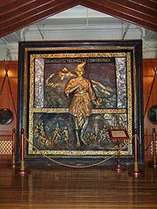
Hang Tuah
Kingdom into the Sultanate of Malacca (Malay: Kesultanan Melaka, Jawi: كسلطانن ملاك). Parameswara changed his name to Iskander Shah (Jawi: إسكندر شه) as well. In 1444, Malacca became ruled by a Hindu king named Abu Syahid Shah. Unlike the other Malay rulers, Shah remained a Hindu and never converted to Islam; yet he was still titled as the Sultan of Malacca. Shah's rule as a non-Muslim sultan was very short-lived, he was murdered by Indian Muslims in 1446. Hang Tuah (Jawi: هڠ تواه), a warrior from Malacca, is considered one of the most inspirational figures in Malay history renowned for his nationalistic battle cry, "Malays will never vanish off of the earth".[23]
Sultanates Outside of the Malay Peninsula
The Islamized Malay culture and influence had begun to spread throughout Maritime Southeast Asia, outside of the Malays' traditional realm, particularily Borneo, southern Thailand and the southern Philippines. This happen via the migration of Malay rulers outside the Malay Peninsula, and spreading their culture to the other natives who in-turn, assimilated into Malay culture. According to Bruneian legend, the Sultanate of Brunei, which at its greatest extent, covered northern Borneo as far north as Manila Bay, was founded by a descendant of Dewa Emas Kayangan, who descended from heaven in married several maidens. Not much is known about the Brunei Sultanate's history, but it reached the height of its extent as a thalassocratic power under Bolkiah, its fifth sultan. Even though Brunei was ruled by sultans of several ethnic origins and intermixes such as Arab, Indian and Chinese, Sultan Bolkiah himself was a Malay. After conquering Sulu, Bolkiah moved to occupy Tondo and Maynila - two prospering states in the Philippine island of Luzon that the latter European powers would also envy and conquer. Bolkiah occupied both kingdoms and converted many of their populations to Islam, renaming Maynila to Selurong - extending the sultanate beyond Borneo and into the Philippines.[24] Shariff Muhammad Kabungsuwan, a missionary from Malacca, emigrated to the southern Philippine island of Mindanao and found the Sultanate of Maguindanao which lasted through 1898, freeing Mindanao from Bolkiah's rule. Kabungsuwan's move to spread Islam in the island of Mindanao was met by resistance from native pagan tribes, whom he soundly defeated, thereby establishing his rule and solidifying his control of Mindanao. He married a local princess and his descendants would join the other Muslim tribes of Mindanao in their war against Spanish conquest. The Sultanate of Patani (1516-1902) was established in southern Thailand, just like Brunei, not much is historically known about Patani's early history or establishment, and can only found through legends and folktales.
Colonial Era 1400s-1965
During the Age of Colonialism, the Malay Archipelago was the target of European powers. It was given the name "East Indies". The Dutch and British came extensively with economic intentions. The
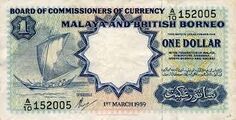
A dollar bill from the British East Indies
Spanish and Portuguese conquistadors (literally Spanish/Portuguese for conqueror) also had the religious intent of converting the natives to Roman Catholicism. Ferdinand Magellan was a Portuguese conquistador who worked for Spain was sent to look for what other Portuguese travelers called the "Spice Islands", which was the Maluku Islands in Indonesia. His slave, who he named "Henrique", a native from Malacca, became his translator and converted him to Catholicism. It is Henrique who accompanied Magellan and allowed him to converse with natives, with played a crucial role in his overseas successes. Instead of finding Indonesia, Megallan discovered the Philippines in 1521 where he and Henrique died in battle against native
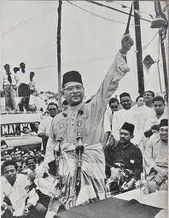
Malaysians celebrate their independence from Britain in 1957
armies in Visayas. Because Islam had such a strong hold in the region, the Portuguese failed to convert the Malays to Catholicism. The Malays fought with heavy resistance setting up Portuguese attempts to convert them to Catholicism for failure. Brunei lost Tondo and Maynila to Spain, consequently those two territories were swiftly Christianized. For some time, the Spanish armies enjoyed successes against the armies of Brunei but had to retreat due to illness in what is known as the Castille War. The Portuguese ceded Singapore and Malaysia to the British and Indonesia to the Dutch. The British and Dutch embraced multi-culturalism rather than assimilation. They even hired sultans and local royalty to govern colonial territories in the islands. The various sultanates became protectorates of the United Kingdom. Amir Hamzah, a Malay Indonesian poet from Langkat, wrote poems and nationalist works for the Indonesian independance cause.
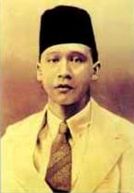
Amir Hamzah
Hamzah was killed by members of the Communist Party of Indonesia in 1945 and reburied properly after his body was found in a mass grave.[25] In 1948, the Federation of Malaya (Malay: Persekutuan Tanah Melayu) was formed, which was carved from 11 states on the Malay Peninsula. This federation formed as a result of Malay displeasure of the preceding Malayan Union, which was to be a British Crown Colony. The Federation of Malaya existed as a British protectorate, with the local Malay rulers exerting their influence and political prestige. In 1963, the Malayan Federation merged and united with the former British Crown colonies of North Borneo (modern-day Sabah) and Sarawak, forming the country today known as Malaysia. In 1965, Singapore, a former Malay state, broke away from Malaysia, becoming the last Malay state to gain independence, though most of its inhabitants were Chinese.
Relations With Other Ethnic Groups
After independence, Malays have experienced many ethnic struggles in Indonesia, Thailand and Singapore. Despite being native to Singapore, Malays in Singapore have experienced social discrimination by their Chinese counterparts, who now make up Singapore's majority. In Thailand, the government did not recognize a "Malay ethnicity", and designated the term "Thai Muslim" for the Malays that inhabit southern Thailand. Even up to now, despite being Muslim and native to Indonesia, there has been many ethnic tensions between Indonesian Malays and the Javanese people, a rivalry that has dated back several millennia before Islam even reached the shores of Sumatra or Java up to Sukarno's opposition to the creation of Malaysia as a state. Despite the ethnic tensions in Indonesia, Indonesian culture is still rooted from Malay culture, such as their national language, Indonesian; which is a form of the Malay language. Malaysia and Brunei's cultures are also of predominant Malay influence, and root strongly from Malay nationalism. The tradition of Malay royalty is preserved in Malaysia and Brunei's politics. Each state in Malaysia is ruled by a sultan, and the country contains a king or head-of-state (Malay: Yang di-Pertuan Agong). In contrast, Indonesia is a republic whose politicians were mostly Javanese. Hamzah Haz, the leader of Indonesia's United Development Party became the country's vice president in 2001-2004, the country's first major Malay politician.
Religion
Historically, Malays were Animists. After the arrival and influence of Chinese and Indian traders and missionaries to Southeast Asia, Malays adopted Hinduism and Buddhism. Today, about 99.9% of Malays are adherents to the Sunni section of Islam. Islam was introduced by Arab traders in Sumatra but spread
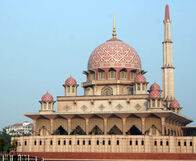
Mosque in Putrajaya, Malaysia's administrative capital
by Indian Muslim and Chinese Muslim converts. In Singapore there is also a group following the Sufi section of Islam, which is a mystical section. According to mainstream Malay tradition, being Muslim is required to be considered Malay and forms a pillar of "Malayness" (Malay: Kemelayuan). Brunei's government imposes very strict laws against non-Muslims, the introducing and preaching of other religions is prohibited in Brunei, whereas it is allowed in Malaysia with strict regulations. Brunei and Malaysia's federal court systems are also influenced by Islam, anyone converting out of Islam must go to the courts to get his/her conversion legally recognized. Anyone who converts out of Islam in Malaysia or Brunei would no longer be recognized a Malay.
Language
The Malays speak an Austronesian language known commonly as Malay, which is a pluricentric language. It is the national language of Malaysia (as Malaysian), Indonesia (as Indonesian), Brunei; one of Singapore's official languages and a minority in Thailand and Australia. The most commonly spoken dialects are the Indonesian and Malaysian registers of Malay.
Standard Malay
The main standard dialect that we come to know as "Malay" as a lone proper term is spoken in Malaysia, Brunei and Singapore, this version is officially recognized as Bahasa Melayu in Singapore and Brunei which literally translates to "Malay language", and in Malaysia it is known as Bahasa Malaysia, or Malaysian language. It is descended from the Malaccan dialect, and functions as the national languages of Malaysia and Brunei, and one of four official languages in Singapore. In Malaysia and Brunei, it is mostly spoken as a second language since the various Malay groups of the two countries speak their own dialects of Malay. Malay was the official language of the Malayan independence movement. It was changed to Bahasa Malaysia (Malaysian language) to create a sense of unity among all ethnic groups in Malaysia, and is referred to as Bahasa Malaysia by the non-Malay groups, while the Malays continue to refer to it as Bahasa Melayu.
Indonesian
Malay is also the national language of Indonesia and is designated as Bahasa Indonesia (Indonesian language) which contains 80% cognates with its Malaysian counterpart, and is also descended from the Malaccan dialect. The development of an Indonesian language occured during the colonial era, where more than half of the population spoke Javanese. A lingua franca was needed, but one that would not favor a single ethnic group (Javanese in this case). The Malay language, having been the lingua franca of the archipelago for millenia was already well-understood by many people, and was the language used to convert natives to certain religions such as Islam and Christianity. Therefore, Malay was chosen as the unifying language of politics, education and nationalism. The developing of Bahasa Indonesia was very successful, and allowed for the unification of the Indonesian archipelago. Indonesians distinguish Bahasa Melayu and Bahasa Indonesia as two different languages, contrary to the Malaysian point of view.[26] Indonesians associate Bahasa Melayu with Malaysia, and also enjoys the status as a separate local and indigenous language from Indonesian. When one does not include the Indonesian language, the Malay language is the second-most spoken local language in Indonesia from Javanese.
Other Dialects
The Yawi language, or Bahasa Jawi is Malay dialect spoken in the Malaysian state of Kelantan and the southern regions of Thailand, most notably the Patani province. It is also known as "Kelantan-Patani Malay" (Malay: Melayu Patani-Kelantan). It speakers number about 1,000,000 in Thailand and 1,500,000 in Malaysia. The various Malay groups from Indonesia, Malaysia and Brunei speak their own dialects of Malay before learning Indonesian or Standard Malay. Although Standard Malay is Brunei's national language, Bruneian Malay or Brunei Melayu is the natively spoken dialect among the people. Bruneian Malay is not too intelligible with Indonesian or Malaysian. There is also another group native to Sumatra known as the Minangkabau people, who share a very identical culture with the Malays. There is dispute between historians and linguists alike as to whether the Minangkabau language should be considered a dialect of Malay or an seperate language.[27] As Indonesia is a very large and diverse country, the country is home to many local Malay dialects and creoles spoken by non-Malay groups. The same can be said of the eastern parts of the Malaysian state of Sabah as well as the southern Philippines.
Writing system
The modern Malay language, as well as Indonesian, is written in the Latin script, known as Rumi. For centuries, an Arabic script known as Jawi (not to be mistaken for Bahasa Jawi) was used. Rumi gradually replaced Jawi. The Jawi script is mostly used by the conservative Muslim royal families in Malaysia, Brunei, Singapore and the southern Philippines. Jawi is co-official to Rumi in Brunei, and is an alternative in Malaysia, especially in the state of Kelantan.
English and Arabic
Due to Malaysia and Singapore's histories as former British territories, the two countries have absorbed the English language to where it is spoken as a language of bussiness. English is one of Singapore's four official languages, and while Malaysian is the national languageo of Malaysia, English is also officially recognized. As a result, Malays are proficient in English. A form of code-switching in Malaysia, between English and Malay (or other languages) is known as Bahasa Rojak, though it is commonly discouraged. In addition, due to the historical signifance of Islam in Malay culture, many learn tend to learn and try Arabic as a second language, particularily those in Singapore.
Architecture
Traditional Malay architecture is built on wood. Malay-style houses are known as kampongs or kampung in
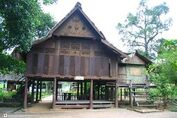
Indonesian. The word can also refer to the slums in Indonesia and Malaysia. Kampongs are built on stilts to resist flooding. Kampongs resemble and reflect the common wood architectures in Southeast Asia, similar houses ar
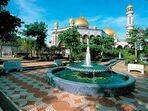
Sultan's Palace in Brunei
e built by the Dayak, Batak, Javanese, Minangkabau and Toraja people of Indonesia, and
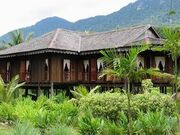
the Muslim groups in the southern Philippines and Sabah in Malaysia.[28] Historically, Malay architecture has been influenced by the major religions that have thrived in the Malay Peninsula and the Malay Archipelago, including Hinduism, Buddhism and Islam. Because Malays are devout Muslims, they have become assimilated into mainstream Islamic culture. Modern-day mosques in Malaysia, Indonesia and Brunei are built according to mainstream Islamic architecture, which is mainly influenced by Indo-Islamic architecture. These include typical elements of a mosque; a dome, a mineret and everything else of Arab, Persian or Indian influence. The largest mosque in Southeast Asia is located in the Indonesian capital of Jakarta. There are Malays who want to stick to traditional culture, Malay-style mosques do exist in Malaysia and Indonesia.
Cuisine
Malay cuisine is a distinct type of Asian cuisine and also depends on the region itself. The biggest differences can be found between Singaporean Malay, Thai Malay and Indonesian
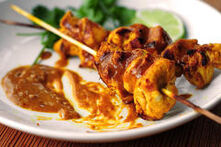
Satay
Malay culinary traditions. Generally, Malay cuisine also contains a mix of Indian and Arab influence with some hints of Chinese - especially in Singapore and Thailand. Common meats include chicken and beef; since Malays are a maritime ethnic group, seafoods are also predominant in Malay cuisine. Staple grains include rice. Common spices and ingredients are nutmeg (Indonesian mostly), chillies, curry, coriander, lemon grass and coconut milk. The use of curry was brought over by Indian traders and missionaries. Satay (Malay for saute) is a grilled and marinated food made with skewering meats, seafoods or vegetables. Satay is usually dipped in a sweet, spice and/or sour sauce. Satay is not necessarily a "Malay dish", but a popular food in Malay-speaking countries, even non-Malay countries like Thailand; despite having a large Malay population in the south. Rice is served with every meal. Any dish that
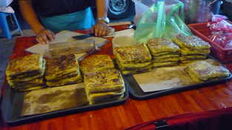
Murtabak
start with the word nesi or nasi mean that the dish is being served with rice, since the word nesi itself literally means rice. A typical rice dish would be nesi lemak. An even more popular rice dish is nesi biryani, which is a spicy rice dish originated from Persia and South Asia, brought over by Indian merchants and missionaries. Rendang is a spicy beef curry dish from the neighboring Minangkabau people in Sumatra. Because Indonesian Malays were also native to Sumatra, the rendang dish also became popular with Indonesian Malays; the dish aslo also spread up north to the Malay communities of Malaysia where it is most popular and the Muslim regions of the southern Philippines where it is served on big occasions. Murtabak is a folded food that resembles pancakes, brought over by Arab traders from Saudi Arabia. The fillings for murtabak can vary from sweet pastes to meats and entrée foods and is wrapped in banana leaves, a tradition common in all
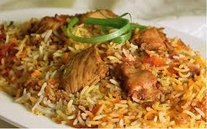
Nesi Biryani
Southeast Asian cuisines. Coconut milk is typically used for sauces, such as satay sauce. Indonesian Malay cuisine contains more more distinct spices such as nutmeg and spices more native to Indonesia. Singaporean and Thai Malay cuisine contain a lot of Chinese influence. The Malay cuisines of Malaysia and Brunei are more strictly influenced by Arab, Islamic and indigenous influences. Islamic culinary and ethical laws, known as Halal (Arabic: حلال) is very predominant in Malay culinary traditions. Malays practice the act of purity which includes not eating anything that is filthy or processed unless it is the only available food for a heavily sick or dying person. Pork and alcohol are always absent from any Malay meal, again; unless a sick or dying person can only consume pork. In Brunei, alcohol is prohibited from public sales, however overseas alcohol sales is permitted for non-Muslims. Many restaurants that are owned by Muslim families recieve Halal certifications. Malays barely use utensils, they use their right hands for eating. This practice can be seen with other ethnic groups of southern Asia, Muslim or non-Muslim. Many Malays do eat on tables, but those who are devout Muslims take part in the traditional Sunnah (Arabic: سنة) and eat cross-legged on the floor.
Notable Malays or People of Malay Origin
| Parameswara | A Hindu prince from modern-day Singapore, converted to Islam and found the Sultanate of Malacca, he was also the last king of Singapura who ruled from 1389 to 1398. The king fled the island kingdom after a Majapahit naval invasion in 1398 and founded his new stronghold on the mouth of Bertam river in 1402. Within decades, the new city grew rapidly to become the capital of the Malacca Sultanate. |
| Hang Tuah | A legendary Malay warrior who lived during the reign of Sultan Mansur Shah of the Sultanate of Malacca in the 15th century. He was the most capable of all the laksamana, or sultan's admirals, and is considered in Malaysia to be one of history's greatest silat masters. Hang Tuah is held in the highest regard, even in present-day Malaysian Malay culture, and is arguably the most well-known and illustrious warrior figure in Malaysian history and literature. |
| Enrique of Malacca | Also known as "Enrique", Ferdinand Magellan's Malaccan slave who helped him translate between Spanish/Portuguese and Malay on his voyages, he was a native of the Malay Archipelago and one of the first people to circumnavigate the world. He likely perished in the Philippines along with Magellan. |
| Sri Lumay | Also known by Rajamuda Lumaya, a minor prince from Sumatra, of Malay and Tamil descent, sent by the Chola Empire to colonize the Philippine island of Cebu and establish it as a vassal state. According to Visayan folklore, he eventually rebelled, founding his own kingdom - colloquially known as the Rajahnate of Cebu. He was known for his scorched-earth policies against the Muslim invaders from Mindanao - where the name Cebu originates, from the Old Malay and Old Cebuano word Sugbu or Sugbo, meaning "scorched-earth" |
| Sharif Kabungsuwan | Founder of Maguindanao sultanate who re-located from Malacca in Malaysia to the Philippine island of Mindanao, he is one of the figures in Philippine history known to have introduced and hastened the spread of Islam in the southern Philippines, battling pagan natives and solidifying Islamization of the island and marrying a local princess, one of his descendants, Muhammad Dipatuan Kudarat - is a national hero of the Philippines |
|
Hassanal Bolkiah |
The current sultan of Brunei, he is also the first and incumbent Prime Minister of Brunei. The eldest son of Sir Muda Omar Ali Saifuddien III and Raja Isteri Pengiran Anak Damit, he succeeded to the throne as the Sultan of Brunei, following the abdication of his father on 4 October 1967. due to Brunei's high abundance and oil, he was at one point the richest man in the world |
|
Tunku Abdul-Rahman |
Chief Minister of the Federation of Malaya from 1955, and the country's first Prime Minister from independence in 1957. He remained as the Prime Minister after Sabah, Sarawak, and Singapore joined the federation in 1963 to form Malaysia. He is widely known simply as "Tunku" or "The Tunku" (a princely title in Malaysia) and also called Bapa Kemerdekaan (Father of Independence) or Bapa Malaysia (Father of Malaysia). |
| Mahathir Mohamad | A Malaysian politician who served as the fourth Prime Minister of Malaysia. He held the post for 22 years from 1981 to 2003, making him Malaysia's longest serving Prime Minister. His political career spanned almost 40 years. During his tenure as Prime Minister, Malaysia experienced a period rapid modernization and economic growth, and his government initiated a series of bold infrastructure projects. He was a dominant political figure, winning five consecutive general elections and holding off all of his rivals for the leadership of UMNO. |
| Anwar Ibrahim | A Malaysian politician, who is the leading figure of the People's Justice Party, a prominent left-wing political party in Malaysia. He served as the Deputy Prime Minister of Malaysia from 1993 to 1998, and Finance Minister from 1991 to 1998. He was a former member of the United Malays Nasional Organisation, a right-wing Malay nationalist party. |
| Azizulhasni Awang | A Malaysian professional track cyclist, the winner of gold medals in the keirin and 200m sprint events at the Asian Cycling Championships in April 2008. He is among 2012 London Olympics gold medal prospects. In 2009, he became the overall winner of the Keirin event in the 2008–2009 World Cup after obtaining two gold medals and became the first Malaysian to win a medal at the UCI Track Cycling World Championships |
|
Yunalis Zarai |
Commercially known as Yuna, a Malaysian singer, songwriter, and businesswoman. In 2012, Yuna was recognized with a National Youth Icon Award, awarded by the Prime Minister of Malaysia, Datuk Seri Najib Razak, for her exceptional achievements in arts. She also co-owns a women's clothes boutique, IAMJETFUEL shop in Subang Jaya, Selangor. |
| A Malaysian singer, songwriter, record producer, television presenter and businesswoman. Since her debut, she has won a number of international singing competitions, including Voice of Asia in 2002, in 1999 she had won Gold Award in Asia New Singer Competition at Shanghai Asia Music Festival. Also, in the same year, she had won two awards from 'South Pacific International Song and Singing Competition 1999' held in Gold Coast, Queensland, Australia. To date, she has garnered more than 200 local awards as well as international awards. | |
| Sheikh Muszaphor Shukor | A Malaysian orthopaedic surgeon and was the first Malaysian to go into space. He was launched to the International Space Station aboard Soyuz TMA-11 with the Expedition 16 crew on October 10, 2007. He flew under an agreement with Russia through the Angkasawan program, and returned to Earth on October 21, 2007, aboard Soyuz TMA-10 with the Expedition 15 crew members, Fyodor Yurchikhin and Oleg Kotov. He is the first Malaysian, Malay and Muslim into outer space. |
| Hamzah Haz | An Indonesian politician. He served as the head of the United Development Party (PPP) from 1998 to 2007, and served as the ninth Vice-President from 2001 until 2004. In the 2004 presidential election, Hamzah Haz was one of the presidential candidates, running with team-mate Agum Gumelar. The pair finished last among the five candidates, garnering only 3 percent of the total vote. He is Indonesia's first major Malay politician. He was also a newspaper journalist in his home town of Pontianak, on the island of Borneo, and later taught economics at Tanjungpura University |
|
Amir Hamzah |
An Indonesian poet and National Hero of Indonesia. Born into an aristocratic family in the Sultanate of Langkat in North Sumatra, he was educated in both Sumatra and Java. After Indonesia proclaimed its independence in 1945, he served as the government's representative in Langkat. The following year he was killed in a social revolution led by the Communist Party of Indonesia and buried in a mass grave. |
| Hatta Rajasa | An Indonesian politician was the former Coordinating Minister for Economic Affairs in the Second United Indonesia Cabinet and the vice presidential candidate with Prabowo Subianto in the Indonesian Presidential Election, 2014. Previously, he was the State Secretary, Minister of Transport, and Minister for Research and Technology in the Mutual Assistance Cabinet (2001-2004). |
| Roekiah |
An Indonesian kroncong singer and film actress. The daughter of two stage performers, she began her career at the age of seven; by 1932 she had become well known in Batavia, Dutch East Indies (now Jakarta, Indonesia), as a singer and stage actress. Around this time she met Kartolo, whom she married in 1934. The two acted in the 1937 hit film Terang Boelan, in which Roekiah and Rd Mochtar played young lovers. During her life she was a fashion and beauty icon, featuring in advertisements and drawing comparisons to Dorothy Lamour and Janet Gaynor. |
|
Erwin Gutawa |
An Indonesian composer and father of Gita Gutawa. In 1985, he started his professional music career by joining the jazz band Karimata, later becoming an independent composer in 1991. As a composer, he won the 1992 Midnight Sun Song Festival in Finland together with Ruth Sahanaya. In 2001 he won the Anugerah Musik Indonesia award for best music arranger for his concert Rockestra. |
| Salmah Ismail |
Better known as Saloma, a Singaporean-Malaysian film actress and singer who became famous in late 50's until early 80's. She was the second of three girls in her family, the other two being Mariani and Mimi Loma. Saloma was the third wife of the film actor, director, singer, and songwriter, Tan Sri P. Ramlee. |
| Yusof bin Ishak |
First president of Singapore. He was also well known both as a journalist and the founder of the Malay newspaper Utusan Melayu prior to becoming head of state of Singapore. He was married to Noor Aishah. He first served as Yang di-Pertuan Negara (head of state) between 1959 and 1965, remaining in office during the time that Singapore was part of the Federation of Malaysia between 1963 and 1965. Following Singapore's departure from Malaysia in 1965, he served as the first President of the Republic until his death in 1970. |
| Halimah Yacob |
A Singaporean politician, a member of the country's governing People's Action Party (PAP), she is currently the ninth Speaker of Parliament, having assumed office on 14 January 2013. She is the first woman to hold this post in the Republic's history. She is the third consecutive Speaker belonging to a minority race, after Abdullah Tarmugi and Michael Palmer. She also served as Minister of State at the Ministry of Community Development, Youth and Sports from 2011 to 2013. She has been a Member of Parliament (MP) representing the Jurong Group Representation Constituency since 2001. |
| Yaacob Ibrahim |
A Singaporean politician. A member of the governing People's Action Party (PAP), he is the country's Minister for Communications and Information, and Minister-in-charge of Muslim Affairs. A Member of Parliament (MP) since 1997, he was the Minister for Community Development and Sports from 2003 to 2004, as the Minister for the Environment and Water Resources from 2004 to 2011, and as the Minister for the Information, Communications and the Arts from 21 May 2011 to 1 November 2012. |
| Surin Pitsuwan |
A politician from southern Thailand who served as the Minister of Foreign Affairs jn Thailand from 1997 to 2001 and as General Secretary of ASEAN from 2008 to 2012, he was born in Nakhon Si Thammarat, into an assimilated Thai-Muslim family of Malay descent. From 2004 to 2006 he was also a favorable candidate to succeed Kofi Annan as the General Secretary of the United Nation. |
Works Cited
- ↑ http://www.epu.gov.my/html/themes/epu/images/common/pdf/eco_stat/pdf/1.2.5.pdf
- ↑ https://www.cia.gov/library/publications/the-world-factbook/geos/bx.html
- ↑ http://www.bps.go.id/65tahun/SP2010_agregat_data_perProvinsi.pdf
- ↑ https://www.cia.gov/library/publications/the-world-factbook/geos/th.html
- ↑ https://www.cia.gov/library/publications/the-world-factbook/geos/sn.html
- ↑ http://en.wikipedia.org/wiki/Yijing_(monk
- ↑ http://en.wikipedia.org/wiki/Kedukan_Bukit_inscription
- ↑ http://en.wikipedia.org/wiki/Melayu_Kingdom
- ↑ http://www.ancientworlds.net/aw/Article/543335
- ↑ http://www.britannica.com/EBchecked/topic/562024/Srivijaya-empire
- ↑ http://www.britannica.com/EBchecked/topic/358901/Majapahit-empire
- ↑ 12.0 12.1 Cite error: Invalid
<ref>tag; no text was provided for refs namedMunoz - ↑ Munoz, Paul Michel (2006). Early Kingdoms of the Indonesian Archipelago and the Malay Peninsula. Singapore: Editions Didier Millet. pp. 163. ISBN 981-4155-67-5. http://books.google.co.id/books/about/Early_kingdoms_of_the_Indonesian_archipe.html?id=NqwuAQAAIAAJ&redir_esc=y.
- ↑ Cite error: Invalid
<ref>tag; no text was provided for refs namedKenneth R. Hall 1975 pp. 318-336 - ↑ Cite error: Invalid
<ref>tag; no text was provided for refs namedC. Majumdar 1961 pp. 338-342 - ↑ Southeast Asia: Past and Present by D.R. Sardesai p.43
- ↑ Early kingdoms of the Indonesian archipelago and the Malay Peninsula by Paul Michel Munoz p.161
- ↑ Buddhism, Diplomacy, and Trade: The Realignment of Sino-Indian Relations by Tansen Sen p.226
- ↑ The Rajahnate of Cebu, The Bulwagan Foundation Trust.
- ↑ http://www.malaysiahistory.net/v2/?p=135
- ↑ http://longlivezhenghe.blogspot.com/2007/08/zheng-he-and-islam-in-southeast-asia.html
- ↑ http://www.infoplease.com/ipa/A0900121.html
- ↑ http://en.wikipedia.org/wiki/Hang_Tuah
- ↑ http://www.infoplease.com/country/brunei.html
- ↑ http://en.wikipedia.org/wiki/Amir_Hamzah
- ↑ http://www.omniglot.com/language/articles/malayisanvindonesian.htm
- ↑ http://www.omniglot.com/writing/minangkabau.htm
- ↑ tcdc2.undp.org/GSSDAcademy/SIE/Docs/Vol4/Malay_house.pdf















